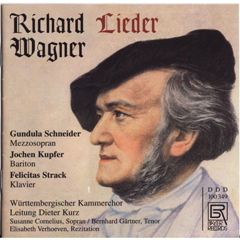Wagner - Samtliche Lieder (G. Schneider) [2006]
Wagner - Samtliche Lieder (G. Schneider) [2006]

Pariser Lieder 01. "La tombe dit а la rose - WWV 56" - 2:15 02. "Dors, mon enfant - WWV 53" - 2;42 03. "Extase - WWV 54" - 2:18 04. "Attente - WWV 55" - 1:15 05. "Mignonne - WWV 57" - 2:03 06. "Tout n'est qu'image fugitives - WWV 58" - 2:24 07. "Les deux grenadiers - WWV 60" - 6:26 08. "Les adieux de Marie Stuart - WWV 61" - 6:50 Die Sieben Kompositionen zu Goethes "Faust" 09. "Lied der Soldaten" - 1:31 10. "Bauern unter der Linde" - 3:19 11. "Brandners Lied" - 1:35 12. "Lied des Mephistopheles (I) - Flohlied" - 1:32 13. "Lied des Mephistopheles (II) - Standchen" - 1:10 14. "Gretchen am Spinnrade" - 2:17 15. "Melodram (Gretchen)" - 3:45 16. "Gruss seiner Treuen" (an Friedrich August, den Geliebten) - WWV 71 - 5:52 17. "Der Tannenbaum - WWV 50" - 3:34 Wesendonck Lieder - WWV 91a 18. "Der Engel" - 2:44 19. "Stehe still" - 3:20 20. "Im Treibhaus" - 4:37 21. "Schmerzen" - 2:30 22. "Traume" - 4:05 Gundula Schneider, mezzosoprano Jochen Kupfer, baritone Susanne Cornelius, soprano Bernhard Gartner, tenor Elisabeth Verhoeven, rezitation Felicitas Strack, piano Wurttembergischer Kammerchor Dieter Kurz, conductor
The circumstances under which Richard Wagner composed his Wesendonck Lieder are nearly legendary. In May of 1849 the fall of the provisional government that led the Dresden rebellion put an end to Wagner’s revolutionary activities. He was forced to flee, first to Weimar, then, with the help of Liszt, to Zurich, Switzerland, where he sought the support of friends.
While in exile in Zurich Wagner continued to work on his theoretical works and the opera Das Rheingold; he also participated in the local musical life. One thing that did not change for him during his exile was the precariousness of his pecuniary position. That is to say that, as usual, he was broke.
Enter Otto Wesendonck, a wealthy silk merchant who, in 1852 made Wagner a generous loan. But what is more important to our narrative is the introduction of Mrs. Wesendonck, the young, pretty, and artistic wife of the merchant, who quickly fell under Wagner’s spell. Wagner, however, had equally succumbed to Mathilde’s charms, resulting in her becoming both his lover and muse.
It was in 1854 that two currents came together in Wagner’s life to give birth to the idea for his opera Tristan und Isolde: his reading of the philosopher Arthur Schopenhauer, and his ongoing love for Mathilde. In August of 1857 he set aside work on the opera Siegfried to begin work on the poem for Tristan und Isolde. While all of this was happening, Otto Wesendonck, who had bought an estate outside of Zurich, allowed Wagner and his wife Minna to move into a cottage on the grounds for a nominal fee. This took place in late April of 1857. As he worked at the poem of Tristan beginning in August, the close proximity to Mathilde induced him to read to her each evening his work in progress. (It was during this time that Wagner made the acquaintance of his future wife Cosima, just then a newlywed to his friend, the conductor Hans von Bülow; but that’s another story.)
This intense inter-action with the poet-composer inspired Mathilde to compose five passionate poems of her own, which Wagner set for voice and piano, during the winter of 1857 as he worked on the first act of Tristan. Mathilde later wrote in her memoirs that he took each of her poems upon their completion and gave to them a “supreme transfiguration and consecration” with his music.
“Der Engel” is based on a passage from Das Rheingold, meaning it is largely diatonic. The text relates the compassion of Angels who risk the force of gravity to carry earthly spirits up to heaven. Wagner sets the first and last stanzas in G major when describing the angelic realm, contrasting it with G minor to render the pained human heart languishing on earth. “Stehe still” is a plea to Time to stop its ceaseless circles so that the supplicant might experience the emptiness of pure being. The restlessness of the music setting the first two stanzas gives way to a more static, tender music as “eye drinks rapture from eye.” “Im Treibhaus” is perhaps the most Schopenhauerian text of the cycle with its emphases upon the nothingness of reality. The recurring ascending melodic pattern reaches toward and embraces the void. This music later found its way into the Prelude to Act III of Tristan und Isolde. In “Schmerzen,” the poet reflects upon the paradox that “if death brings forth life/and sorrow only bring delight/O how thankful am I that Nature/granted me such sorrows.” Like “Im Treibhaus,” “Träume” is a study for Tristan. The longing for dissolution of being – so profoundly expressed in the opera by way of a harmonically chromatic palette – paints in this song “an everlasting image: oblivion, remembrance!” ---laphil.com
download (mp3 @320 kbs):
yandex 4shared mega mediafire zalivalka cloudmailru uplea








